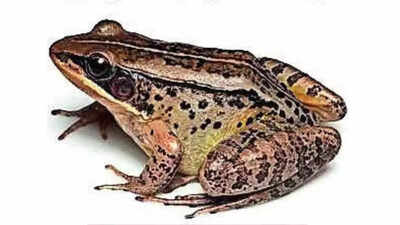Scientists have uncovered a new species of frog belonging to the genus Nidirana in Arunachal Pradesh, India. The discovery, based on morphological, molecular, and acoustic evidence, marks the first record of this genus in India.
The newly identified species, named Nidirana noadihing, stands out from its congeners due to a distinct combination of morphological features. As described in an article published in the November 15th edition of the journal Zootaxa, the frog exhibits a “robust” body with a rounded snout and smooth skin adorned with bony protrusions on its back. Males typically measure between 1.8 and 2.3 inches in length, while females range from 2.4 to 2.6 inches long.
Researchers Bitupan Boruah, V Deepak, and Abhijit Das stumbled upon this unique frog during field surveys conducted in Changlang and Lohit districts of Arunachal Pradesh between August and September 2022. They observed male frogs emitting loud calls while nestled amidst vegetation in shallow pools of water. Additional specimens were detected in nearby marshy areas, along the edges of a newly constructed pond, and near a roadside.
A total of five specimens, three males and two females, were collected for further analysis. The species was named Nidirana noadihing in recognition of the Noa-Dihing river, which flows near the location where the frogs were discovered.
The Noa-Dihing Music Frog exhibits a striking appearance, featuring a pale cream line bordered by dark brown running down the center of its body. Its light brown limbs are adorned with dark stripes, and its eyelids bear irregular-shaped and sized spots. Around their moderately large eyes, dark stripes stand out, while their gold-rimmed pupils rest within dark brown irises speckled with gold. The throat, forelimbs, thighs, and lower legs of these amphibians appear light brown and pinkish, while their groin and the outer sides of their thighs are pale yellow with irregular dark olive patches. Their cream-colored chest and belly exhibit a golden tinge.
Nidirana species are typically associated with swampy habitats, ponds, and paddy fields, often constructing nests to lay their eggs. However, the Noa-Dihing Music Frog distinguishes itself from other species in its genus by its size, oval toe tips, tubercles on its back, and unique call.
This remarkable discovery underscores the importance of exploring specialized habitats like marshlands, which often receive less attention but harbor a wealth of biodiversity.
